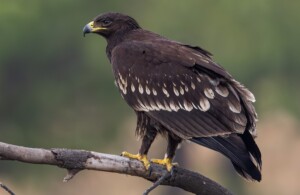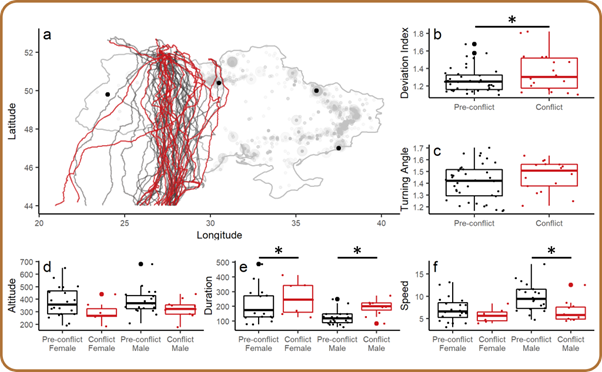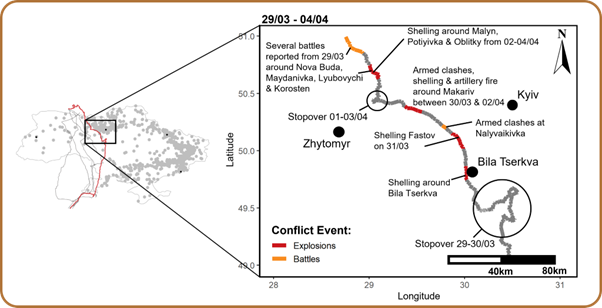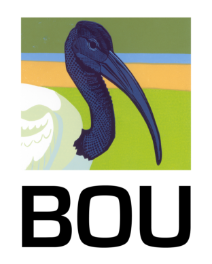
LINKED PAPER
Active European Warzone Impacts Raptor Migration. Russell, C., Franco, A., Atkinson, P., Vali, U., Ashton-Butt, A. 2024. Current Biology. DOI: 10.1016/j.cub.2024.04.047 VIEW
Greater Spotted Eagles are charismatic wetland specialists, acting as important umbrella and indicator species for the conservation of threatened wetlands. However, they are under pressure from a range of anthropogenic threats throughout their annual cycle, including habitat loss, persecution and hybridisation, driving long-term population declines and range contractions in the European population. Fewer than 1,000 breeding pairs of Greater Spotted Eagles remain in Europe largely restricted to small populations centred around scarce wetland habitats, with an important stronghold (~15% of the population) in Polesia – a landscape of wetlands and forests around the River Pripyat spanning 18 million hectares along the border between southern Belarus and northern Ukraine. The Estonian University of Life Sciences, British Trust for Ornithology, and in-country partners, started tagging Greater Spotted Eagles breeding in Belarusian Polesia in 2017. Using movement data from these birds, we aimed to identify important areas for the species that we could then use to inform conservation efforts.
We did not expect to be following these birds as they migrated through a warzone in early 2022 with this species facing a new threat: navigating a complex armed conflict event.
Artillery fire, jets, tanks, and other weaponry increased the potential disturbance encountered whilst migrating through Ukraine, with unprecedented numbers of soldiers moving through the landscape and more than 10 million civilians displaced.

Figure 1. Greater Spotted Eagle © CC BY-SA 2.0 Imran Shah.
Our understanding of how conflict events directly impact wildlife is limited by the logistical and ethical challenges of undertaking research in these areas, so our tracking data from 21 birds provided a unique window into how exposure to conflict events affected migratory behaviour. Compared to migrations in pre-conflict years, Greater Spotted Eagles flew further, and less directly, to their breeding grounds, with this prolonged migration taking them longer (Figure 2) and we observed a 90% reduction in stopover site use during this period.

Figure 2.Pre-conflict spring migration (2019-2021, black, n=41) and spring migration during the Russia-Ukraine conflict (2022, red, n=19) routes (A) and performance metrics (B-F) for 22 Greater Spotted Eagles passing through Ukraine from 44° latitude to their breeding grounds. (A) Migration routes are shown in relation to major cities (points) and areas of conflict (grey). (B-F) migration performance metrics comparing pre- and during conflict migrations including: (B) route deviation index; (C) average turning angle (radians); (D) average altitude of migration (metres); (E) time taken to cross Ukraine (hours) and (F) average migration speed (metres per second).
Greater Spotted Eagles were not observed to circumnavigate conflict areas entirely, with avoidance behaviours occurring on a more local scale, probably around sporadic and instantaneous events such as artillery fire or shelling. Abrupt disturbances can trigger immediate panic or escape responses in wildlife. We believe that individuals exposed to these events may respond in a variety of ways, deviating their flight path to flee or seek refugia increasing the distance travelled. Coupled with the decreased use in stopover sites limiting their ability to recover fitness, these behavioural changes associated with the conflict in 2022 likely increased the energetic costs of migration, risk of mortality and had sublethal fitness effects.

Figure 3. Migration tracks for Denisa showing the 2022 spring migration (red) and pre-conflict migrations (grey) in relation to conflict areas from ACLED data highlighting exposure to specific conflict events (inset). Denisa was exposed to multiple conflict events south-west and west of Kyiv, flying within 1km of reported explosions and battles which coincided with a slowing of migration, increased deviation index and westward movement away from these events and more intense conflict zones.
So what does this mean for Greater Spotted Eagles? These migrations are already incredible feats, and any additional fitness costs at this crucial stage could carry over into the breeding season impacting productivity. Our tagged eagles mostly migrated through central and western Ukraine, where fighting has since subsided. Much of the vital breeding population in Polesia migrate through or breed in eastern Ukraine, where intense conflict events are still ongoing. These birds will be exposed to conflict-related disturbances on a longer timescale, and during the more sensitive breeding period, meaning that our results are likely an underestimate of the true impacts of war on Greater Spotted Eagles. This is on top of how military activity can cause widespread habitat degradation, the erosion of measures in place to protect wildlife, and impacting our relationship with the environment.

Figure 4. Greater Spotted Eagle in wetland area © Bernard Castelein.
There are also wider questions for how human conflicts impact wildlife. Our understanding of how wars impact the environment is growing, and the profile of this issue is being pushed to the fore by Ukraine. Reports of the effects on dolphins, bats and the destruction of the Kakhovka Dam in this conflict all contribute to evidence of ecocide in war, but it is likely happening in conflicts across the globe. Work like this is important for supporting not just Greater Spotted Eagles but wider ecosystems in a (hopefully soon) post-conflict setting.
This work was supported by the Natural Environment Research Council and the ARIES Doctoral Training Partnership [grant number NE/S007334/1].
Image credits
Top right: Greater Spotted Eagle Clanga clanga © CC BY-NC 2.0 Hari Patibanda.
Blog posts express the views of the individual author(s) and not those of the BOU.
If you want to write about your research in #theBOUblog, then please see here





